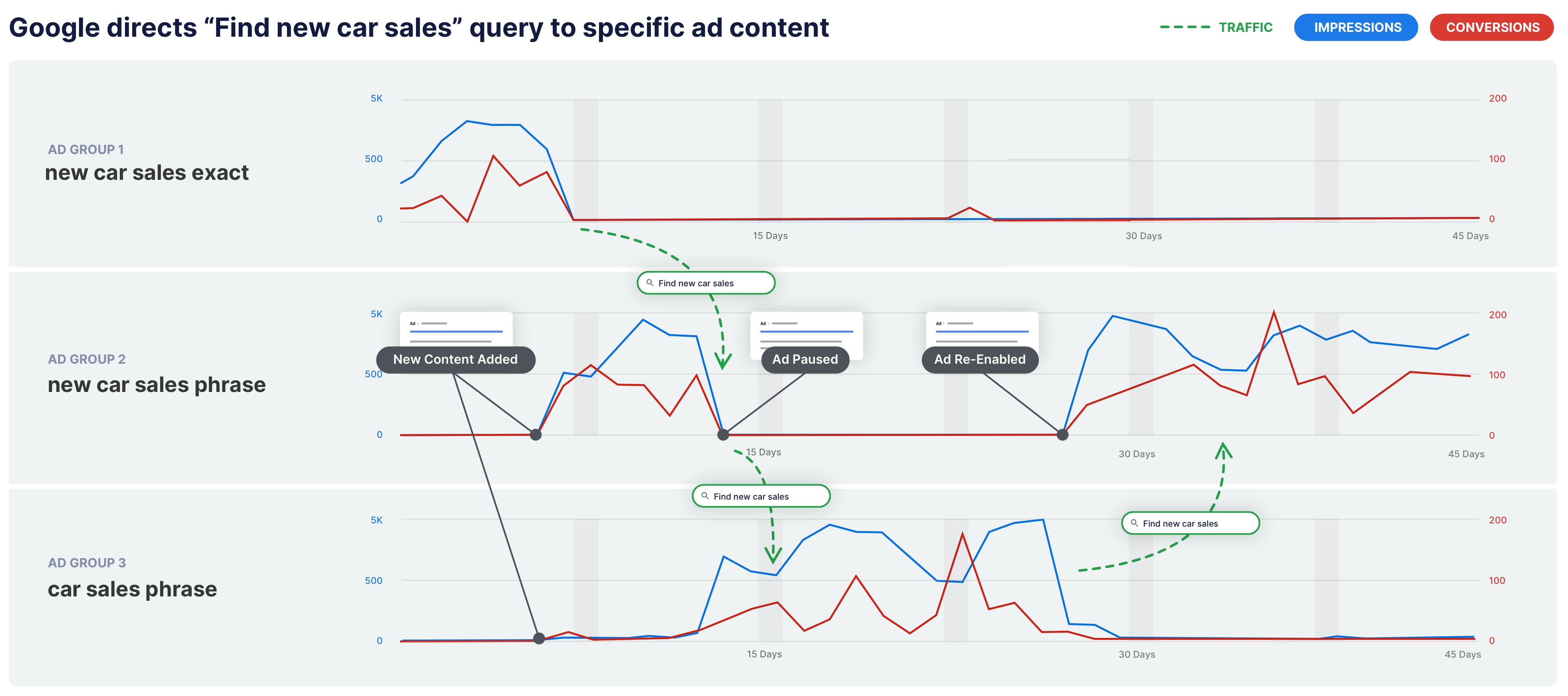Ads are the New Keywords: A Paid Search Case Study

Over the last 10 years paid search has evolved from a keyword-targeting system to a match-making system in which content-to-intent alignment as determined by advanced AI models are the primary driver used for audience targeting. This has dramatically increased the importance of ad copy in Paid Search, making it more important than keywords or match types for audience targeting and performance. In this post we will review a recent case study that proves unequivocally that ads are the new keywords.
Before the incorporation of AI into ad delivery Search Engine traffic was segmented and bid upon through keywords, which is what made keywords the center of this universe, with other assets like ads playing a supporting role. Match types of exact, broad and phrase were leveraged to drive different levels of performance and audience reach by impacting how search queries were matched to keywords by search engines. However, in the last 10 years, a lot has changed as more AI and machine learning has advanced and improved on how ads are matched to audiences. The relationship between the keyword and the search query has been methodically obscured and now almost entirely replaced by the relationship between ad content and individual user search intent
In addition to the Google timeline above, which helps see how their product development has evolved toward AI match-making, the deprecation of Extended Text Ads (ETAs) by Google and more recently Bing have brought this AI evolution to the forefront of search engine technology. With ETAs advertisers created ads. Now advertisers just provide ad parts, headlines and descriptions, as building materials for search engine AI technology. With Responsive Search Ads (RSAs) Google and Bing are now dynamically building the ads from advertiser-supplied content to uniquely match the best possible ad to each individual user’s true search intent - which is understood using Machine Learning and Natural Language Technology.
From one RSA Google can build over 40K unique permutations. So for an Ad Group that could have as few as 1 keyword and 3 RSAs that’s nearly 130K unique ads that can be created. Applying AI to matching each user to an individually built ad opens up the capability for these systems to use all the data they have about a user beyond what they simply type into the search box to determine the potential value of every individual auction. The expanded utilization of Smart Bidding has enabled Search Engines to charge advertisers a premium for less aligned content, while reducing pricing to promote highly aligned content. Ultimately, the primary role of AI is to maximize user experience by matching ads to each user and minimizing advertiser controlled constructs including keywords, match types, and even max CPCs.
How do we know this, and how can we see it if this layer is invisible to the advertiser? Let’s go through a case study that shows how Google prioritizes ad content over keywords and match types for audience matching:

- During the first week, you can see that all of the traffic for the search term “find new car sales” is coming in on the exact match keyword [new car sales].
- Then in the 2nd week, we deployed an ad with the headline “Find New Car Sales” into ad groups 2 & 3. You can see that immediately, all of the traffic from that search term immediately jumps to the phrase match keyword “new car sales”, since clearly this headline is an excellent match for that specific search term.
- At the end of week 2 we paused the ad in ad group 2, but left it running in ad group 3. Here you can see that the traffic from that query then jumps to the phrase match keyword “car sales”, where the same ad is still enabled. This continues until the 4th week, when we re-enabled the ad in ad group 2, and the search term jumps back to ad group 2, again matching with its “favorite ad” across the ad groups.
- One other key takeaway here is that performance peaks when the search term is coming in through its “favorite ad” in weeks 2, 5, and 6.
This case study shows how queries jump from ad group to ad group to match up with “the right ad”, and how google rewards you for making that match possible with the right ad copy. In this particular case, it is also obvious why Google prefers to match the search term “find new car sales” with the headline “Find New Car Sales” because it is perfectly aligned.
Given this new reality, what does this mean for advertisers? Having ad copy align with keywords used to be sufficient, but this new reality means advertisers must make sure that their ads cover a much broader landscape of intent and motivation than just what is in the keywords directly. Ad variations must cover the intent contained in search terms, and even the motivations beyond the search term.
To use a sports metaphor - you gotta have the keywords to be in the game, but the ball is going to go to where the content best aligns with the search intent.
